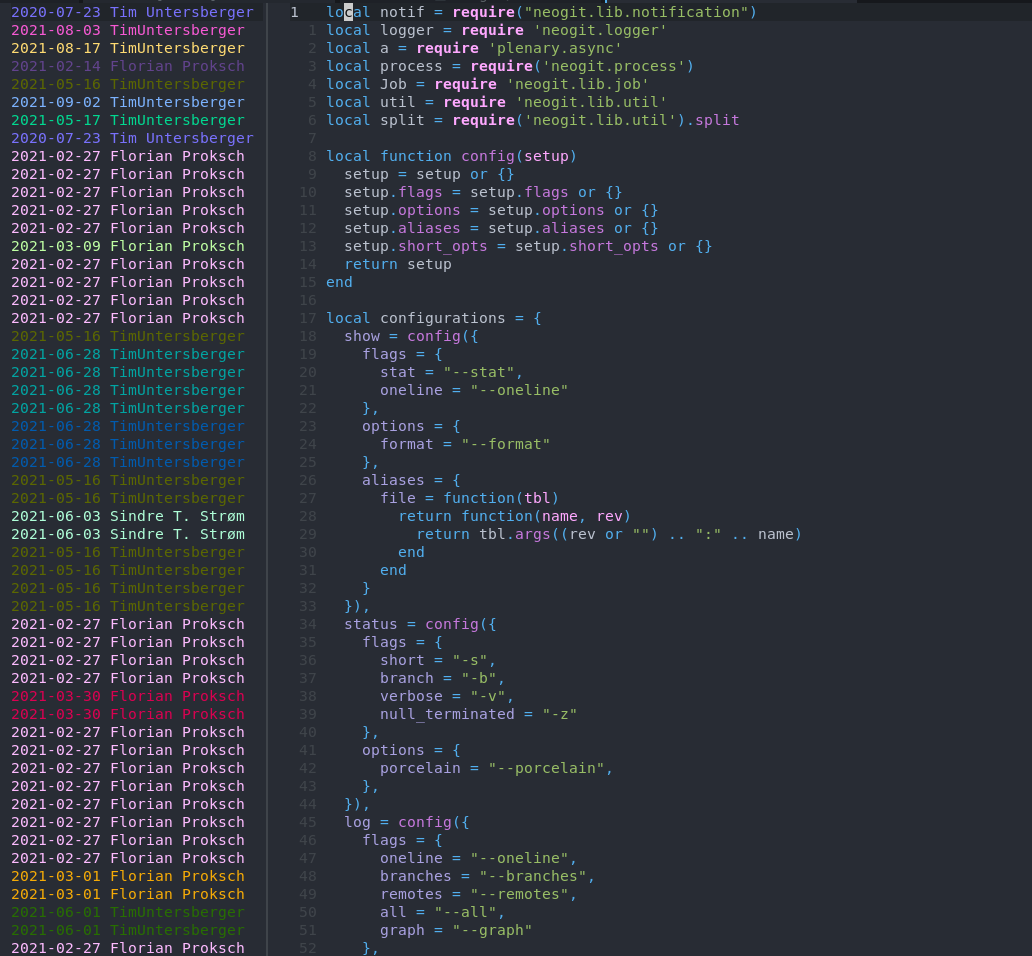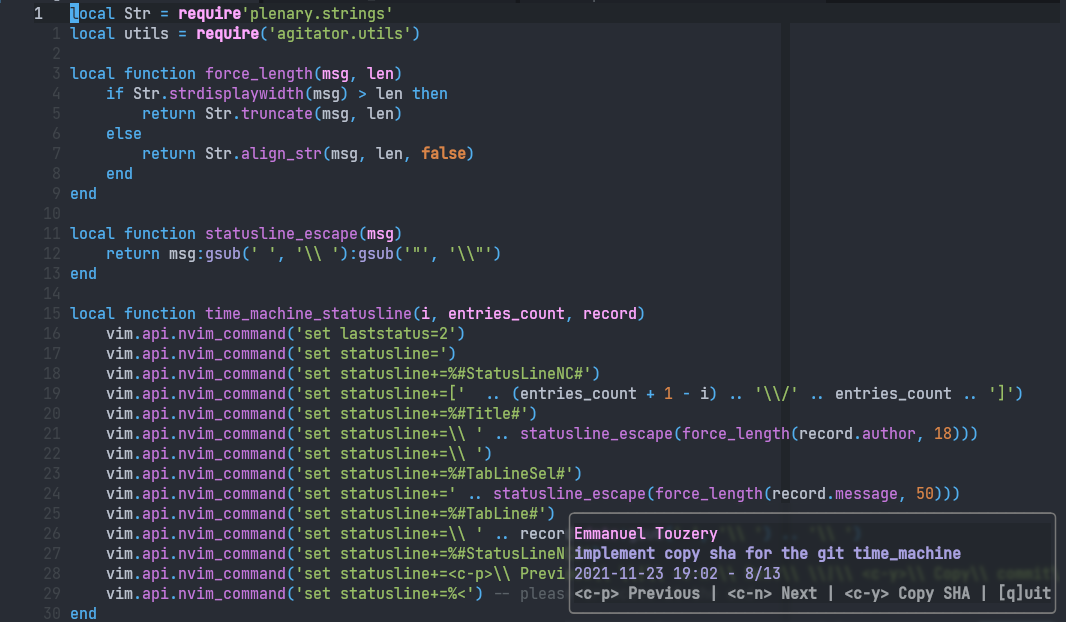Ecosyste.ms: Awesome
An open API service indexing awesome lists of open source software.
https://github.com/emmanueltouzery/agitator.nvim
https://github.com/emmanueltouzery/agitator.nvim
git lua neovim neovim-lua-plugin neovim-plugin nvim
Last synced: 2 months ago
JSON representation
- Host: GitHub
- URL: https://github.com/emmanueltouzery/agitator.nvim
- Owner: emmanueltouzery
- License: mit
- Created: 2021-11-20T20:03:36.000Z (almost 3 years ago)
- Default Branch: main
- Last Pushed: 2024-03-17T08:58:27.000Z (7 months ago)
- Last Synced: 2024-06-25T22:39:56.894Z (3 months ago)
- Topics: git, lua, neovim, neovim-lua-plugin, neovim-plugin, nvim
- Language: Lua
- Homepage:
- Size: 67.4 KB
- Stars: 61
- Watchers: 2
- Forks: 0
- Open Issues: 3
-
Metadata Files:
- Readme: README.md
- License: LICENSE
Awesome Lists containing this project
README
# agitator.nvim
agitator is a neovim/lua plugin providing some git-related functions:
## blame

Blame adds a window on the left side of your window with blame information for the file.
The sidebar is scroll bound to the main file window.
Three functions are exported:
- `git_blame({sidebar_width?, formatter?})`: open the sidebar. The default width is 30 characters, you
can optionally pass another width in a record, eg `{sidebar_width = 20}`. You can also pass in a
formatter function, to display the commit information, see lower;
- `git_blame_close()`: close the blame sidebar;
- `git_blame_toggle()`: toggle (open or close) the blame sidebar.
- `git_blame_commit_for_line()`: get the git commit SHA for the current line, as string.
This last function, to get the commit SHA, can allow to display the commit for a certain line of code.
However you'll need an external plugin to display the commit, such as [neogit](https://github.com/TimUntersberger/neogit)
or [diffview.nvim](https://github.com/sindrets/diffview.nvim/).
Here is an example of integration with diffview:
```lua
function _G.ShowCommitAtLine()
local commit_sha = require"agitator".git_blame_commit_for_line()
vim.cmd("DiffviewOpen " .. commit_sha .. "^.." .. commit_sha)
end
```
The formatter function for `git_blame()` lets you customize the rendering of the blame information.
For instance, you could call:
```lua
require'agitator'.git_blame{formatter=function(r) return r.author .. " => " .. r.summary; end}
```
And you'd get in a sidebar the author and the commit summary instead of the author and date, which is
the default.
The formatter function receives a single parameter, which has the following fields:
- author
- summary
- date, which is a `os.date` which has among others `year` `month` and `day` fields.
## git find file
Git find file will open two telescope pickers in succession. The first one to
pick a git branch; the second one to pick a file from that branch.
The selected file from another branch is then displayed in a read-only buffer.
- `open_file_git_branch()`
## search in git branch
search git branch will open two telescope pickers in succession. The first one to
pick a git branch; the second one to enter text to search for in that branch.
The selected file from another branch is then displayed in a read-only buffer.
- `search_git_branch()`
## search in added lines
search in added will open a telescope picker to search in lines that you've
added compared to your git checkout: basically you search in the git diff.
- `search_in_added()`
## time machine

The time machine allows you to see the history of a single file through time.
It opens a new read-only window, where you can navigate through
past versions of the file and view their contents.
Details about the currently displayed version appear in a popup window at the bottom-right.
- `git_time_machine({use_current_win?, set_custom_shortcuts?, popup_last_line?, popup_width?})`
You can pass in `{use_current_win: true}` to reuse the current window instead of creating a new one.
`set_custom_shortcuts` allows to customize the shortcuts for the time machine.
It should be a function, that'll receive the buffer number of the time machine.
You should set up the autocommands you want; you can reproduce the default behavior with this implementation:
```lua
{
set_custom_shortcuts = function(code_bufnr)
vim.keymap.set('n', '', function()
require"agitator".git_time_machine_previous()
end, {buffer = code_bufnr})
vim.keymap.set('n', '', function()
require"agitator".git_time_machine_next()
end, {buffer = code_bufnr})
vim.keymap.set('n', '', function()
require"agitator".git_time_machine_copy_sha()
end, {buffer = code_bufnr})
vim.keymap.set('n', 'q', function()
require"agitator".git_time_machine_quit()
end, {buffer = code_bufnr})
end
}
```
If you change the shortcuts for instance, you'd probably want to change the shortcut hints at the bottom
of the popup window. You can do that with the `popup_last_line` option. You can reproduce the default
behavior with this implementation:
```lua
{ popup_last_line = ' Previous | Next | Copy SHA | [q]uit' }
```
You can also change the popup width with `popup_width`. The default value is currently 53.
## General
To call any function, if you use a plugin manager such as Packer, you must
prepend `require('agitator')`. For instance `require('agitator').git_blame()`.
I'm really a beginner in nvim/lua, so don't be surprised if some things are
strangely or wrongly implemented. There are also a couple of ugly hacks. Pull
requests are welcome. I'll do my best to fix bugs, but don't expect too much.
This plugin has two dependencies: [telescope.nvim](https://github.com/nvim-telescope/telescope.nvim/)
and [plenary.nvim](https://github.com/nvim-lua/plenary.nvim).
The plugin is meant to be combined with [gitsigns](https://github.com/lewis6991/gitsigns.nvim),
[neogit](https://github.com/TimUntersberger/neogit) and [diffview](https://github.com/sindrets/diffview.nvim),
so I won't add features covered by these.